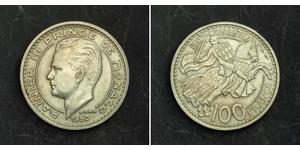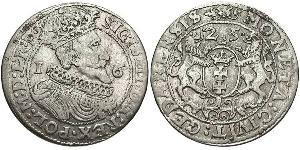(sold for $60.0)
1764, Austrian Netherlands, Francis I Stephen. Silver Thaler (Kronentaler) Coin.
Mint Year: 1764
Reference: Davenport 1283, KM-22.
Denomination: Kronenthaler (crown thaler)
Condition: Polished/smoothed, otherwise F-VF.
Mint Place: Brussels (Belgium) - Cupid's face mintmark.
Weight: 29.05gm
Diameter: 41mm
Material: Silver
Obverse: Crown above double headed imperial eagle with crowned composite shield of arms at chest. Large Toison d'or collar around.
Legend: FRANCIS . D . GRATIA ROMAN . JMPERAT . S. A . A . (cupid's head)
Reverse: The Golden Fleece Order hanging on a flintstone underneath a fire iron with flames, St.Andrew's Cross in background. Crowns of Austria, Hungary and Bohemia in fields.
Latin Legend: GERM . JERO . REX LOTH . BAR . MAG . HET . DUX . I764
The Kronenthaler was a silver coin first issued in the Austrian Netherlands (see Austrian Netherlands Kronenthaler). It contained one ninth of a Cologne mark of silver and was thus equal to the Reichsthaler of the Leipzig convention. Most examples show the bust of the Austrian ruler on the obverse and four crowns on the reverse, hence the name which means "crown thaler". After the Austrian Netherlands was occupied by France, several German states (Bavaria, Baden, Hesse-Darmstadt and Württemberg) issued Kronenthaler, as it had become a popular trade coin.
em>.
Francis I (Francis Stephen; 8 December 1708 â€" 18 August 1765) was Holy Roman Emperor and Grand Duke of Tuscany, though his wife effectively executed the real power of those positions. With his wife, Maria Theresa, he was the founder of the Habsburg-Lorraine dynasty.
He was born in Nancy, Lorraine (now in France), the oldest surviving son of Leopold Joseph, duke of Lorraine, and his wife Élisabeth Charlotte d'Orléans, daughter of Philippe, duc d'Orléans. He was connected with the Habsburgs through his grandmother Eleanore, daughter of Emperor Ferdinand III, and wife of Charles Leopold of Lorraine, his grandfather. He was very close to his brother and sister Anne Charlotte.
Emperor Charles VI favored the family, who, besides being his cousins, had served the house of Austria with distinction. He had designed to marry his daughter Maria Theresa to Francis' older brother Clement. On Clement's death, Charles adopted the younger brother as his future son-in-law. Francis was brought up in Vienna with Maria Theresa on the understanding that they were to be married, and a real affection arose between them.
At the age of 15, when he was brought to Vienna, he was established in the Silesian Duchy of Cieszyn, which had been mediatized and granted to his father by the emperor in 1722. Francis Stefan of Lorraine succeeded his father as Duke of Lorraine in 1729. Maria Theresia of Austria had organized in 1732 that Francis became "Lord Lieutenant" (locumtenens) of Hungary. He was not excited about this position, but Maria wanted him closer to her. In June 1732 he agreed to go to Presburg.
The emperor Charles VI, Holy Roman Emperor, at the end of the War of the Polish Succession, agreed to compensate the French candidate Stanislaus Leszczynski, (father-in-law of Louis XV of France) for the loss of his crown in 1735.
France's prime minister, Cardinal Fleury, saw the Polish struggle as a chance to strike at Austrian power in the west without seeming to be the aggressor. While he cared little for who should become King of Poland, the cause of protecting the King's father-in-law was a sympathetic one, and he hoped to use the war as a means of humbling the Austrians, and perhaps securing the long-desired Duchy of Lorraine from its duke, Francis Stephen, who was expected to marry Emperor Charles's daughter Maria Theresa, which would bring Austrian power dangerously close to the French border.
A preliminary peace was concluded in October 1735 and ratified in the Treaty of Vienna in November 1738. Augustus was confirmed as king of Poland, Stanisław was compensated with Lorraine (which would pass on his death, through his daughter, to the French), while the former Duke of Lorraine, Francis Stephen, was made heir to the Grand Duchy of Tuscany, which he would inherit in 1737.
Although fighting stopped after the preliminary peace in 1735, the final peace settlement had to wait until the death of the last Medici Grand Duke of Tuscany, Gian Gastone in 1737, to allow the territorial exchanges provided for by the peace settlement to go into effect.
In March 1736 the Emperor persuaded Francis, his future son-in-law secretly (!) to exchange Lorraine for the Grand Duchy of Tuscany. France had demanded that Maria Theresa's fiancé surrender his ancestral Duchy of Lorraine to accommodate the deposed King of Poland. The Emperor considered other possibilities (such as marrying her to the future Charles III of Spain) before announcing the engagement of the couple. If something would go wrong, Francis would become governor of the Austrian Netherlands.
Elisabeth of Parma had also wanted the Grand Duchy of Tuscany for her son Charles III of Spain; the Grand Duke of Tuscany, Gian Gastone de' Medici was childless and was related to Elisabeth via her great grandmother Margherita de' Medici. As a result Elisabeth son's could claim by right of being a descendant of Margherita.
On January 31, 1736 Francis had agreed to marry Maria Theresia. He hesitated three times (and laid down the feather before signing). Especially his mother Élisabeth Charlotte d'Orléans and his brother Prince Charles Alexander of Lorraine were against the loss of Lorraine. On February 1, Maria Theresia send Francis a letter: she would withdraw from her future reign, when a male successor for her father would appear.
They married on February 12 in the Augustinian Church, Vienna. The wedding was held on February 14, 1736. The (secret) treaty between the Emperor and Francis was signed on May 4, 1736. In January 1737, the Spanish troops withdrew from Tuscany, and were replaced by 6,000 Austrians. On January 24, 1737 Francis received Tuscany from his father-in-law. Until then, Maria Theresa was Duchess of Lorraine.
Gian Gastone de' Medici, who died on 9 July 1737, was the second cousin of Francis. In June 1737 Francis went to Hungary again to fight against the Turks. In October 1738 he was back in Vienna. In December 17, 1738 the couple travelled south, accompanied by his brother Charles to visit Florence for three months. They arrived on January 20, 1739.
In 1744 Francis' brother Charles married a younger sister of Maria Theresia, Archduchess Maria Anna of Austria (1718â€"1744). In 1744 Charles became governor of the Austrian Netherlands, (until his death in 1780).
Maria Theresia secured in the Treaty of Füssen his election to the Empire on 13 September 1745, in succession to Charles VII, and she made him co-regent of her hereditary dominions.
Francis was well content to leave the wielding of power to his able wife. He had a natural fund of good sense and some business capacity and was a useful assistant to Maria Theresa in the laborious task of governing the complicated Austrian dominions, but his functions appear to have been primarily secretarial. He also took a great interest in the natural sciences. He was a member of the Freemasons.
Francis was quite the philanderer and was known for his many indiscreet affairs, notably one with Princess Auersperg, who was thirty years his junior. This particular affair has been remarked upon the letters and journals of visitors to the court and his children.
He died suddenly in his carriage while returning from the opera at Innsbruck on 18 August 1765. He is buried in tomb number 55 in the Imperial Crypt in Vienna.
Maria Theresa and Francis I had sixteen childrenâ€"their youngest daughter was the future queen consort of France, Marie Antoinette (1755-1793). He was officially succeeded by his eldest son Joseph II although the real power remained with his wife. Another son was the Emperor Leopold II.

|
Posted by:
anonymous 2016-02-17 |
3 Reichsmark Weimar Republic (1918-1933) Silver
group has 76 coins / 73 prices
⇑
















-300-150-sIsKbzbijOMAAAFR_3lauz1K.jpg)






